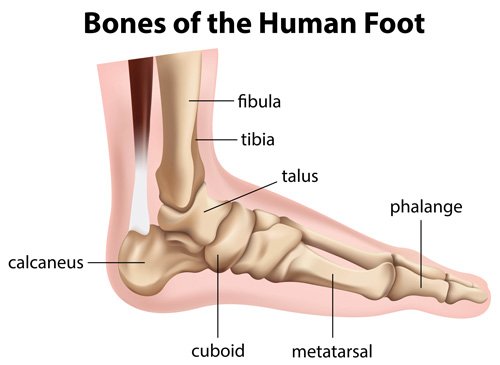Did I Sprain Or Break My Ankle?
If you have pain in your ankle, you know that something’s gone wrong. But you can’t always tell if you’re just experiencing a temporary problem, or if you’re facing a more serious injury. Even more complicated? When you do know that you’re hurt, it’s often tough to tell the difference between a sprained or broken ankle. Ankle sprains and fractures (also called a break) can cause pain, bruising and swelling. And, both conditions can make it difficult to bear weight on your foot.
Why do these injuries present with similar symptoms? Well, your feet and ankles are full of tendons, cartilage, ligaments and bones. Your ankle has three main bones: the talus (ankle bone), the fibula (outer bone of the lower leg) and your tibia (shinbone). Pain and pressure in your ankle could indicate damage to any of these structures.
Differences in Sprains and Fractures
Ankle sprains and fractures are usually caused by tripping, falling or twisting your ankle in an awkward way and are common sports injuries. An ankle fracture may also be the result of a direct impact injury such as a car accident. Since ankle sprains and fractures share similarities (difficulty in bearing weight on your foot, pain, bruising and swelling), keep reading to learn about the differences between each condition.
A sprained ankle describes a stretch or tear to your ligaments. These ligaments are the connective tissue that hold your ankle bone together and help to stabilize your joint. Most ankle sprains affect the ligaments on the outer part of the foot. There are three types of ankle sprains based on the severity of the of ligament damage.
Grade 1: Mild Sprain – The ligaments are stretched.
Grade 2: Moderate Sprain – A ligament is partially torn, but there isn’t a complete tear.
Grade 3: Severe Sprain – Ankle ligaments are completely torn.
Symptoms of a sprained ankle may include:
Pain that gets worse over time.
Inability to bear weight on your foot (either immediately or after several hours).
Bruising.
Swelling.
Ankle instability.
Limited range of motion.
A fractured ankle describes a crack or break in your bone. You make break one or more bones in your ankle joint. An X-ray or other imaging device determines if you have broken any bones. Symptoms of a broken ankle may be similar to those you see with a sprain. Plus, many people sprain and break their bones in one injury. While there are many types of breaks, there are generally five types of fractures.
Stress fracture (also known as a hairline fracture) - Tiny cracks in a bone.
Displaced fracture – When the bone snaps and moves out of alignment.
Non-displaced fracture – The bones are broken but are still together correctly.
Closed fracture – The broken bone has not pierced the skin.
Open fracture – The broken bone has pierced the skin, or the broken bone is visible.
Symptoms of a fractured ankle may include:
Severe pain, usually felt immediately and sometimes with numbness.
Inability to bear weight on your foot (both immediately and after several hours/days).
Bruising.
Swelling.
Visible deformity of the ankle.
Is it a Sprain or Fracture?
So, how do you diagnose a sprained or broken ankle? The best way to tell if you have an ankle sprain or fracture is to make an appointment with our skilled foot and ankle specialist, podiatrist Dr. David Sullivan. While some individuals may be able to walk on a sprained or broken ankle doing so can cause further damage to your ankle and extend your healing time. Untreated ankle sprains can lead to chronic ankle pain, instability and arthritis. Untreated ankle fractures put you at high risk for developing an infection, arthritis and foot deformities that may make it impossible to walk again normally. The safest way to avoid complications is to contact our office as soon as you notice ankle pain.
Dr. Sullivan will diagnose your sprain or fracture after a thorough and careful physical examination. A typical examination includes looking at your ankle, foot and lower part of your leg. He may check for tenderness and range of movement. He may take an X-ray at our office to determine if you have broken any bones or request another form of imaging.
Help for Sprained or Fractured Ankles
In our Westfield, Ind. podiatry practice, typical treatment for sprained ankles includes rest and compression. Icing and over the counter anti-inflammatories can also help with swelling and pain. If your injury is severe, we may provide you with a walking boot or other options to keep weight off your ankle without compromising mobility.
For a broken ankle, the treatment depends on the site of the and severity of the bone fracture. In some cases, surgery may be needed to heal a fractured ankle. Especially if the injury displaced the bone and it is now out of alignment.
Of course, getting the right ankle treatment is the only way to heal properly. But for that to happen, you need an accurate diagnosis. Now, even with the help of this blog, it’s tough to know what kind of ankle injury you’re facing at home. That’s why your best move to make after hurting your ankle is to call us right away and schedule a consultation with Dr. David Sullivan, serving Westfield, Carmel, Noblesville, Fishers and Zionsville, Ind. We’ll get you in the office, diagnose your trauma and heal you as quickly as possible!


